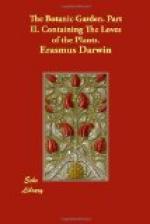O’er her white neck the bristly mane she throws,
290 And binds the gaping whiskers on her brows; 290
Plaits round her slender waist the shaggy vest,
And clasps the velvet paws across her breast.
Next with soft hands the knotted club she rears,
Heaves up from earth, and on her shoulder bears.
295 Onward with loftier step the Beauty treads, 295
And trails the brinded ermine o’er the meads;
Wolves, bears, and bards, forsake the affrighted groves,
And grinning Satyrs tremble, as she moves.
CARYO’S sweet smile DIANTHUS proud admires, 300 And gazing burns with unallow’d desires; 300
[Dianthus. l. 299. Superbus. Proud Pink. There is a kind of pink called Fairchild’s mule, which is here supposed to be produced between a Dianthus superbus, and the Garyophyllus, Clove. The Dianthus superbus emits a most fragrant odour, particularly at night. Vegetable mules supply an irrefragable argument in favour of the sexual system of botany. They are said to be numerous; and, like the mules of the animal kingdom, not always to continue their species by seed. There is an account of a curious mule from the Antirrbinum linaria, Toad-flax, in the Amoenit. Academ. V. I. No. 3. and many hybrid plants described in No. 32. The Urtica alienata is an evergreen plant, which appears to be a nettle from the male flowers, and a Pellitory (Parietaria) from the female ones and the fruit; and is hence between both. Murray, Syft. Veg. Amongst the English indigenous plants, the veronica hybrida mule Speedwel is supposed to have originated from the officinal one; and the spiked one, and the Sibthorpia Europaea to have for its parents the golden saxifrage and marsh pennywort. Pulteney’s View of Linneus, p. 250. Mr. Graberg, Mr. Schreber, and Mr. Ramstrom, seem of opinion, that the internal structure or parts of fructification in mule-plants resemble the female parent; but that the habit or external structure resembles the male parent. See treatises under the above names in V. VI. Amaenit. Academic. The mule produced from a horse and the ass resembles the horse externally with his ears, main, and tail; but with the nature or manners of an ass: but the Hinnus, or creature produced from a male ass, and a mare, resembles the father externally in stature, ash-colour, and the black cross, but with the nature or manners of a horse. The breed from Spanish rams and Swedish ewes resembled the Spanish sheep in wool, stature, and external form; but was as hardy as the Swedish sheep; and the contrary of those which were produced from Swedish rams and Spanish ewes. The offspring from the male goat of Angora and the Swedish female goat had long soft camel’s hair; but that from the male Swedish goat, and the female one of Angora, had no improvement of their wool. An English ram without horns, and a Swedish horned ewe, produced sheep without horns. Amoen. Academ. V. VI. p. 13.]




